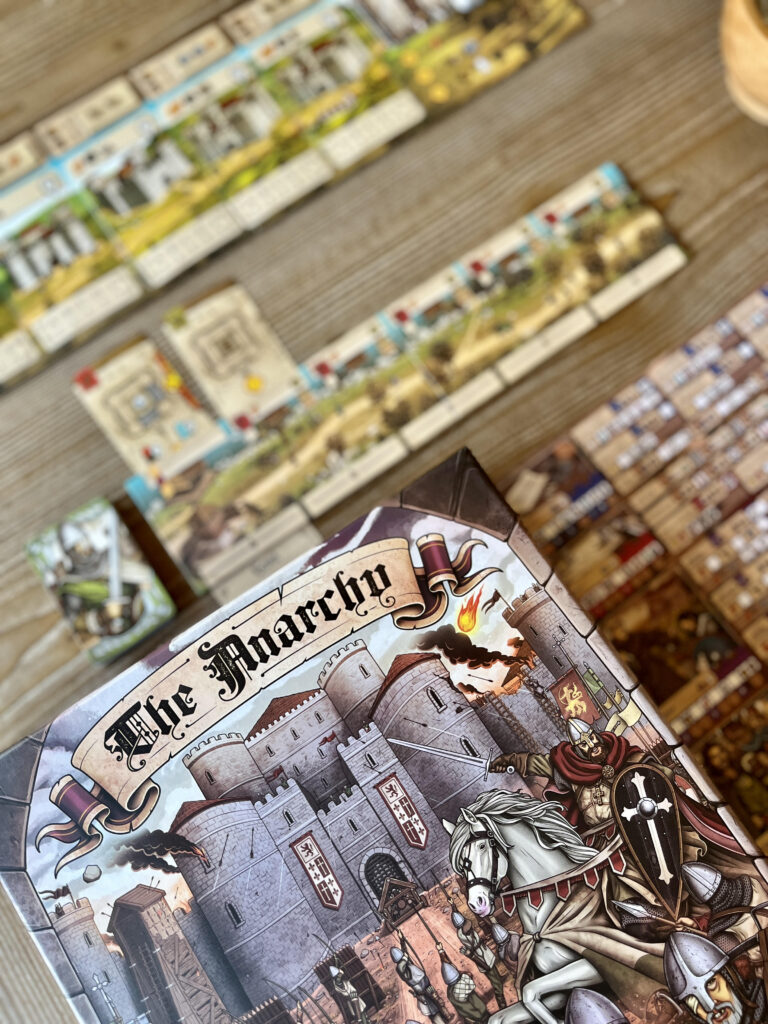I once loved Hadrian’s Wall. Truly. It was crunchy, clever, and satisfying. But like many affairs of the mind, it plateaued. I found a strategy that worked and every attempt to stray felt like I was being punished for curiosity. So I sold it. No regrets, but perhaps a passing sigh.
Now comes The Anarchy, clad in castles and spreadsheets, daring you to think harder, longer, and better. It is, in nearly every way, a denser, more focused, more punishing game. And I mean that as a benediction.
To be clear, I’m not dogging on Hadrian’s Wall. It’s an excellent game, and perhaps the better starting place. I just ran my course with it. But where Hadrian’s Wall was more of a sandbox, The Anarchy is more of a crucible. It burns away the fluff and leaves behind pure, strategic decision making. If you’re willing to meet it on its terms, it hits hard.

The structure is simple on the surface: five rounds. Each one hands you a little pile of stuff (various colored workers, coins, maybe some wood) but none of it rolls over. You get what you get, and you use it or lose it. Every round is its own little world of resource management.
Each worker type can do different things, and the game hands you all sorts of tempting options. You can join tournaments, go to festivals, build buildings, sack neutral castles, research tech, or start up a spy network. It’s a lot. But no matter how many shiny side quests the game throws at you, there’s always a bigger problem looming: the siege. You will be attacked at the end of every round, and it’s always serious. Sometimes you see exactly what’s coming, sometimes the enemy deck teases you with half-clues. Either way, it hurts.
This is the most significant design shift from Hadrian’s Wall. There, defense was one of many things you could dabble in. Here, it’s the whole deal. Everything you do has to funnel toward protecting your castle. Upgrading your walls, manning ballistas, building out gates…this is the spine of the economy. You can chase long-term plans all you want, but if you don’t defend well during the round, none of it matters. The game doesn’t let you coast.
What really makes The Anarchy shine, though, is how tight the decisions are. You’re constantly making painful trade-offs. Most actions demand specific worker types. Some want coins, others need a combo of workers and certain buildings. There’s tech to improve your defenses and some juicy bonus combos, but they’re all locked behind real effort. It’s a system that rewards planning but doesn’t wait around for you to figure it out.
Sacking castles is another layer. These are shared targets in the center of the table, and everyone can try to loot them for rewards. But it’s pricey. Diverting workers and resources to offense means weakening your own defense, so you’re always walking a tightrope between aggression and survival.

Then there’s Worship and Entertainment. These are little subsystems where you can get extra resources or perks by committing the right stuff at the right time. I want to engage with them more, but it’s hard to throw a parade when your front gate is on fire. That said, the more I’ve played, the more I’ve realized that using Lammas for the “Joy” boost it gives is pretty helpful for your final score. So yeah, maybe don’t ignore God’s love of bread.
The solo campaign is where The Anarchy really clicks. It’s 20 chapters long, each with new twists and new score thresholds. It’s not heavy on story, but it is really good at forcing you out of your comfort zone. You can’t just find one winning strategy and ride it…you’ll need to adapt constantly. And it keeps pointing out the parts of the board you’ve been ignoring.
For example, I’ve mostly avoided the Beer section, which gives you a small bonus during defense if you manage to reveal at least four different cards. In theory, great. In practice, way too much setup for not enough payoff…at least in my experience. Same with the Chapels. I like what they do, but giving up food, wood, and silver to build them always feels like a rough trade. But the campaign keeps pushing me to find value in those neglected corners. It forces creativity and makes you rethink what “optimal” even means. There are instances where I’ve used Beer to much better effect and I wouldn’t have done that without the campaign pushing me harder (side note, I have not completed the campaign, but this is my view so far).
Now, is it always fair? Not exactly. There’s some swinginess, especially in the attack deck. I had a game where I drew nothing but gate and wall attacks for four rounds… and then suddenly got slammed with all the tower attacks in the final round. Surprise! Wrecked.
Multiplayer exists, technically. But it’s true multiplayer solitaire. You’ll all be sitting there silently crunching numbers and muttering to yourselves. Which, depending on your friends, might be a selling point. It’s not interactive really, but it is deeply absorbing.
Once the rules click (and yeah, there’s a learning curve) it runs really well. The iconography is clean, the systems make sense, and the tension stays high the whole time. You’re always just barely hanging on, and that’s the fun of it.
So yes, The Anarchy is mathy. And not remotely forgiving. But it’s also brilliant. It doesn’t just want you to solve puzzles, but wants you to evolve and to think better. It asks for your full attention, and when you give it, the reward is real.